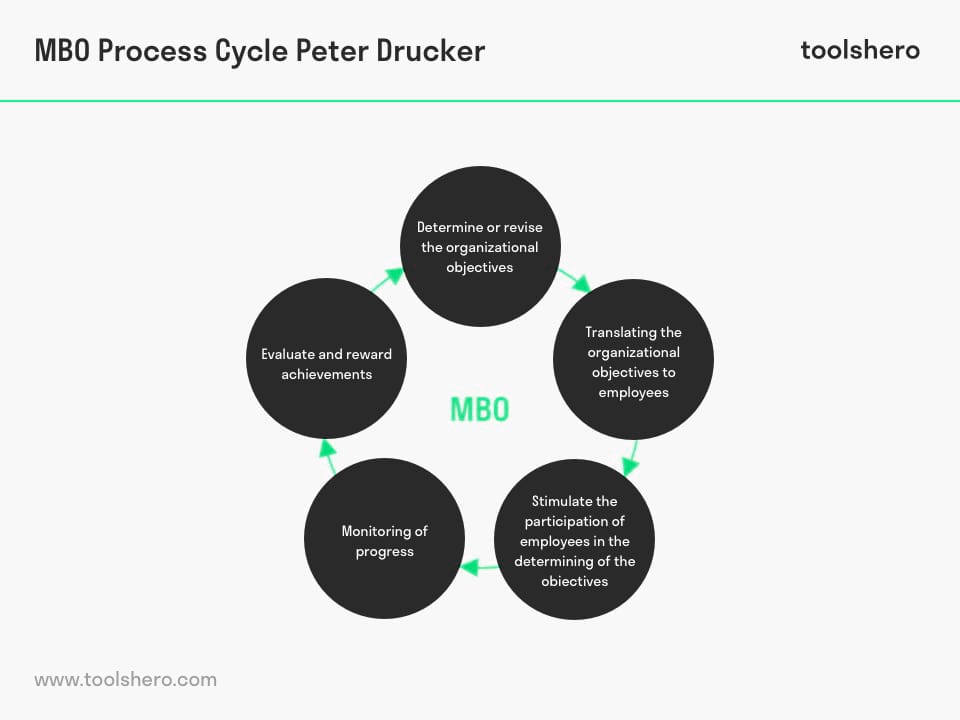Management By Objectives (MBO)

Management By Objectives: his article explains the theory of Management By Objectives (MBO), developed by Peter Drucker in a practical way. Next to what it (definition and essence) is, this article also highlights management By Objectives Process and steps and that it is not a one-off exercise. After reading, you’ll have a basic understanding of this management principle. Enjoy reading!
What is Management By Objectives?
Definition and essence
Management By Objectives (MBO) is a performance management approach in which a balance is sought between the objectives of employees and the company goals. MBO was developed by Peter Drucker, a renowned American author and consultant in the field of Organizational Development and management.
The essence of Peter Drucker ’s basic principle: Management By Objectives is to determine joint objectives and to provide feedback on the results. Setting challenging but attainable objectives promotes motivation and empowerment of employees. It also creates a performance based work environment.
By increasing commitment, managers are given the opportunity to focus on new ideas and innovation that contribute to the development and objectives of organizations. However, Peter Drucker sets a number of conditions that must be met:
- Objectives are determined with the employees or team members;
- Objectives are formulated at both quantitative and qualitative levels;
- Objectives must be challenging and motivating;
- Daily feedback on the state of affairs and key results at the level of coaching and development instead of static management reports;
- Rewards (recognition, appreciation and/or performance-related pay) for achieving the intended objectives is a requirement;
- The basic principle is growth and development not punishments.
Management By Objectives (MBO) is also known as Management By Results (MBR).
Management By Objectives Process and steps
Peter Drucker has developed five steps to put Management By Objectives into practice:

Figure 1 – Management by Objectives Process (Drucker)
1. Determine or revise the organizational objectives
Strategic organizational objectives are the starting points of management by objectives. These objectives stem from the mission and vision of an organization. If an organization has not formulated these yet, it does not make sense to carry out the next steps.
2. Translating the organizational objectives to employees
In order to make organizational objectives organization-wide, it is important that these are translated to employee level. For efficiency reasons, Peter Drucker used the SMART Goals acronym SMART (Specific, Measurable, Acceptable, Realistic and Time-bound).
The element Acceptable is crucial in management by objectives as this is about agreement on the objectives between the employees and the organization. The management by objectives principle does not allow management to determine the objectives by themselves.
According to management by objectives, objectives should be clearly recognizable at all levels, for example customer service, and everyone should know what their responsibilities are in this. Communication is also an important item for consideration when it comes to expectations, feedback and to giving rewards for objectives that have been achieved.
3. Stimulate the participation of employees in the determining of the objectives
The starting point is to have each employee participate in the determining of personal objectives that are in line with the objectives of the organization. This works best when the objectives of the organization are discussed and shared throughout all levels of the organization so that everyone will understand why certain things are expected of them.
In this way, everyone can make their own translation of what their contribution can be to the objectives. This approach increases the involvement and commitment of the objectives. Instead of simply following expectations of managers and executives, everyone in an management by objectives approach will know what is expected of them.
By broadening the decision making process and responsibility throughout the organization, people are motivated to solve the problems they are faced with in an intelligent manner and they are given the information they need so that they can be flexible in the changing circumstances.
This participatory process ensures that personal objectives with respect to general team objectives, department objectives, business unit objectives and ultimately organizational objectives are made clear.
4. Monitoring of the performance
Because the goals and objectives are SMART, they are measurable. If they cannot be measured, a system will have to be set up in which a monitoring function is activated when the objectives are deviated from.
Detection must be timely so that large problems can be prevented. On the other hand, it is important that the agreed objectives do not cause abnormal behaviour of employees for example.
For instance, when a service call must be handled within seven minutes and as a result employees finish these calls after 6 minutes and 59 seconds to meet this requirement. There are always exceptions to a rule and these situations should always be supervised.
In Management By Objectives, employees are not supported by their management through annual performance reviews. Management By Objectives is about growth and development.
Each objective comprises mini objectives and it is about supporting these in small steps in the form of coaching by managers or executives. Create a clear path with sufficient evaluation moments so that growth and development can be monitored accurately.
5. Evaluate and reward achievements, the fifth Management By Objectives priniple and step
Management By Objectives has been designed to improve performance at all levels within an organization. A comprehensive evaluation system is therefore essential. As goals and objectives have been SMART formulated, they make the evaluation of processes very easy.
Employees are evaluated and rewarded for their achievements in relation to the set goals and objectives. This also includes accurate feedback. Management By Objectives is about about why, when and how objectives can be achieved.
The management is supposed to organize frequent meetings in which the progress is discussed between superiors and subordinates.
Management By Objectives (MBO): it is not a one-off exercise
Peter Drucker’s five steps are not a one-off exercise. It is a development cycle that takes the organizational objectives as the starting point and these need to be translated to an individual level.
The message behind Management By Objectives is the jointly determining and achieving of objectives and being rewarded for these achievements. It is important to make fair and correct assessments of the achievements against the setting of measurable goals.
Clear performance indicators are essential for a good management by objectives approach.
It’s Your Turn
What do you think? Do you recognize the practical explanation about Management By Objectives or do you have more suggestions? What are your success factors for the organizational goal setting and achieving business success?
Share your experience and knowledge in the comments box below.
More information
- Drucker, P. F. (2007). Management challenges for the 21st century. Routledge.
- Drucker, P. F. (1995). People and performance: The best of Peter Drucker on management. Routledge.
- Rodgers, R., & Hunter, J. E. (1991). Impact of management by objectives on organizational productivity. Journal of Applied Psychology, 76(2), 322.
How to cite this article:
Mulder, P. (2010). Management By Objectives (MBO). Retrieved [insert date] from Toolshero: https://www.toolshero.com/management/management-by-objectives-drucker/
Published on: 03/14/2018 | Last update: 07/05/2023
Add a link to this page on your website:
<a href=”https://www.toolshero.com/management/management-by-objectives-drucker/”>Toolshero: Management By Objectives (MBO)</a>













5 responses to “Management By Objectives (MBO)”
An effective organisation is where the management adopts a strategy of extraction of the best behaviour from the employees, concentrating on enabling a working atmosphere where teamwork is proliferate.
The concepts of management by objectives was developed by Peter Drucker during 1950s and it has been written on extensively thereafter. The definition of management by objectives is given by Drucker as the process of developing aims in a company to provide a sense of direction to the workforce.
It is also defined as the process of developing the objectives enabling the employees to understand their contribution at the workplace.
Further Drucker indicates that management by objectives is defining the roles and responsibilities for the employees helping them to define their own tasks which contributes to a certain course of action for individual employees, employees as a collective and for the organisation.
Hence the concept of management by objectives is to provide guidance to the employees and hence enabling the delivery of best performance, able to achieve targets within the allocated time frames.
I learned the MBO approach back in the 70s and I have taken that basic framework as my model 40 years. It all boils down to not being a jerk. That’s all.
Thank you for your comment, Chris.
Drucker`s Management by Objectives is not practical.
The above written statement can be supported with some arguments on Drucker`s management by objectives (MBO). According to Drucker, objectives should be single-minded with the employees and should be measurable in terms of quality and quantity as well. Moreover, he states that objectives set should be attainable. And after all, Peter said reward for all the hard work made by employees to achieve targets should be in form of appreciation, recognition or performance-pay with in an organization, which according to me does not motivate an employee to put in his\her hard work attitude in future. And Drucker covered this truth by saying the basic principle is growth of an organization.
An article printed by Greenwood, R., 1981. Management by Objectives: As Developed by Peter Drucker, Assisted by Harold Smiddy describes MBO process cycle which was revised third time in this article. Finally, after so many arguments in journal article it is concluded that nobody in modern times has applied MBO in an organization but few might had applied in earlier times.
Thank you for your comment, Rishabh.